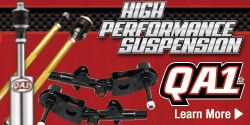ACME SS
Well-Known Member
A few weeks ago I was installing Classic Auto Air, air conditioning in my car and in a matter of 20 minutes I had to discard the lower dash mounted oil pressure gauge and then the tachometer was next. All that was left was the original cluster, of which only the speedometer "worked" although it had the wrong gear. The fuel gauge posed as functional but was less than accurate.
It was time to pull the trigger and do something. I chose Classic Instruments because they provide a new dash panel. The installation was simple, just need to get a schematic and splice into the correct wires. Their instructions could be improved with a schematic showing how to wire up the gauges but I have done that on a few cars in the past so it wasn't difficult. Essentially, you daisy chain the grounds from one gauge to another, as well as the dash light and 12V power wires. All that can be accomplished on the bench. I then installed my own wires to each gauge, approximately 18" in length, enough so I could do all the splices with the panel laying on the steering column with padding under it. Before installing the dash, I zip tied the wires into a loom (not pictured) to relieve any stress from the crimp connections. I'm not a huge fan of crimps but I read an article by Ron Francis wiring years ago that said soldered connections can fail at the solder edge when bent, and this makes sense. So with that in mind, I zip tie such that no bending can take place at the crimp connectors.
I used plasti-dip on the chrome knobs. I did 2 dips and it seems to be OK. We will see how it holds up.
The speedometer is super simple. You replace the cable with a pulse generator at the transmission and plug in the harness provided, which replaces the cable. they provide 3 options to program it. I always choose to use my hiking GPS which is accurate to a few feet of a mile. You simply tell it what a mile is and it then knows how may pulses to a mile. Tach is even easier.
Jerry

![67139952681__5E3F3DC5-A033-4ED7-A245-CF8B4D8EB973[1060].jpg 67139952681__5E3F3DC5-A033-4ED7-A245-CF8B4D8EB973[1060].jpg](https://www.forabodiesonly.com/mopar/attachments/67139952681__5e3f3dc5-a033-4ed7-a245-cf8b4d8eb973-1060-jpg.1715909176/)
It was time to pull the trigger and do something. I chose Classic Instruments because they provide a new dash panel. The installation was simple, just need to get a schematic and splice into the correct wires. Their instructions could be improved with a schematic showing how to wire up the gauges but I have done that on a few cars in the past so it wasn't difficult. Essentially, you daisy chain the grounds from one gauge to another, as well as the dash light and 12V power wires. All that can be accomplished on the bench. I then installed my own wires to each gauge, approximately 18" in length, enough so I could do all the splices with the panel laying on the steering column with padding under it. Before installing the dash, I zip tied the wires into a loom (not pictured) to relieve any stress from the crimp connections. I'm not a huge fan of crimps but I read an article by Ron Francis wiring years ago that said soldered connections can fail at the solder edge when bent, and this makes sense. So with that in mind, I zip tie such that no bending can take place at the crimp connectors.
I used plasti-dip on the chrome knobs. I did 2 dips and it seems to be OK. We will see how it holds up.
The speedometer is super simple. You replace the cable with a pulse generator at the transmission and plug in the harness provided, which replaces the cable. they provide 3 options to program it. I always choose to use my hiking GPS which is accurate to a few feet of a mile. You simply tell it what a mile is and it then knows how may pulses to a mile. Tach is even easier.
Jerry
















